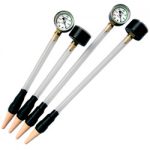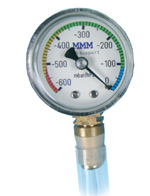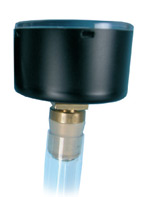
Tensiometer
Description
The tensiometer is a precision device for measuring soil moisture. Measurement of soil moisture notifies you of the need to irrigate plants, and is used to determine the height and frequency of irrigation, because plants growing in optimal humidity can be maximum efficient.
Models: 20 cm, 30 cm, 50 cm, 100 cm (reading from above)
The tensiometer consists of:
- A ceramic filter with fine pores
- Transparent plastic tube (for operation must be filled with water)
- Vacuum gauge with coral scale
- Gaskets
The vacuum gauge measures a pressure in the range of 0 to 600 hPa (= mbar). It is a device with an accuracy class of 1.6, i.e. the deviation of the displayed values is max. +/- 1.6%.
The green color on the colored vacuum gauge scale indicates the optimal humidity range for most species of vegetables, berry plants and fruit trees. This range applies to all soil types (sandy, loam soils).
The vacuum gauge has easy in value interpretation colorful scale. The silicone plug well surrounds the tip of the vacuum gauge, allowing the tensiometer to close tightly, and protects against minor soiling and allows easy filling of the tensiometer with water in the field.
Technical data
| Unit of measurement: | mbar (= hPa) |
| Measurement range: | 0-600 mbar / hPa soil suction power |
| Vacuum gauge: | accuracy class 1.6 (1.6% max.) |
| Closure: | always a tight silicone stopper |
| Tube: | outer diameter 16 mm, diameter ext. 12 mm, wall thickness 2 mm |
| Filter: | 5 cm |
How the tensiometer works
The tensiometer measures the soil suction power, i.e. measures the force with which water will be retained in the soil, and thus the force that the plant roots must bring to get it from the soil. When preparing the tensiometer for operation, fill it with water up to approx. 1 cm below the top edge of the tube and installing it vent the vacuum gauge . Thanks to the ceramic filter, the water in the tensiometer and in the soil is in constant connection. In case when it is dry, the soil draws water from the tensiometer creating a pressure , which is measured by a vacuum gauge. This pressure corresponds to the suction power of the soil. After irrigation or rainfall, when the soil humidity rises, the water begins to flow from the soil into the filter until the potentials between the soil and the tensiometer are equalized. After irrigation, the tensiometer shows the correct value after about 15-30 minutes, because the water must first penetrate into the deeper layers of soil.
Getting started
The tensiometer ceramic filter should be soaked with water before installation. Therefore, an empty strain gauge without a vacuum gauge should be left in a container with water overnight. Water should collect in it by morning. Immediately before installation, the strain gauge should be filled with water to approx. 1-2 cm from the top edge of the tube and the vacuum gauge should be placed tightly on it.
Range of activity
One development unit (development unit is an area with the same soil type and one plant species at the same developmental stage) requires one tensiometer. For more information, i.e. permeation of water used for irrigation, and water uptake by plants from different soil layers, additional strain gauges can be installed at different soil depths (e.g. 50 or 80 cm).
Precautions
To avoid damaging the tensiometer, observe the following precautions:
- the components of the tensiometer must be protected against operations of adverse effects (do not throw it on the ground, do not squeeze it in a vice, do not hammer it into the ground with a hammer, etc.)
- as long as the strain gauge is filled with water, do not expose it to temperatures below 0 ° C
- avoid contact of the ceramic filter with grease, oil and other substances that could clog its pores
Solution of problem
The tensiometer can measure soil suction power even from -700 to -850 hPa, but when the suction power value increases (i.e. the soil dries even more), the water from the tensiometer is completely drawn off and the vacuum gauge shows zero value. The inside of the tensiometer fills with air (the tensiometer is aerating).
Typical applications: strawberries, other berry crops, vegetables, asparagus, crops under cover and in greenhouses; also field crops.

